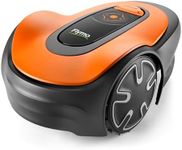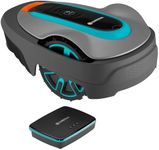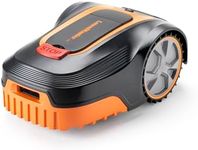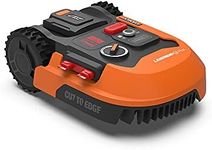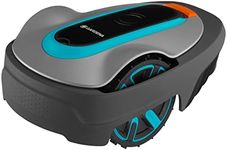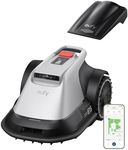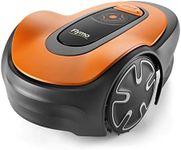Buying Guide for the Best Robotic Lawn Mowers
Robotic lawn mowers are a fantastic solution for maintaining your lawn with minimal effort. They autonomously cut your grass, saving you time and energy. When choosing a robotic lawn mower, it's important to consider various specifications to ensure it meets your lawn's specific needs. Understanding these key features will help you select a model that efficiently manages your lawn's size, terrain, and grass type.Lawn Size CapacityLawn size capacity refers to the maximum area a robotic lawn mower can effectively manage. This is crucial because a mower designed for smaller areas may not perform well on larger lawns, leading to incomplete mowing or frequent recharging. Lawn size capacities are often segmented into small (up to 0.25 acres), medium (0.25 to 0.5 acres), and large (over 0.5 acres). To choose the right one, measure your lawn and select a mower that can handle slightly more than your lawn's size to ensure efficient coverage.
Battery Life and Charging TimeBattery life indicates how long the mower can operate on a single charge, while charging time is how long it takes to recharge the battery. These specs are important because they determine how often the mower needs to return to its charging station and how quickly it can resume mowing. Longer battery life and shorter charging times are ideal for larger lawns. If you have a small lawn, a mower with shorter battery life and longer charging time may suffice, as it will still complete the job efficiently.
Cutting Width and HeightCutting width is the width of grass the mower can cut in one pass, and cutting height is the range of grass height the mower can be set to cut. These specs are important because they affect how quickly and effectively the mower can cover your lawn. Wider cutting widths are better for larger lawns as they reduce mowing time, while adjustable cutting heights allow you to customize the grass length to your preference. Consider your lawn's size and your desired grass height when choosing these features.
Navigation and Terrain HandlingNavigation and terrain handling refer to the mower's ability to move around obstacles and manage different types of terrain, such as slopes or uneven ground. This is important for ensuring the mower can cover your entire lawn without getting stuck or missing areas. Mowers with advanced navigation systems and good terrain handling are ideal for complex lawns with many obstacles or varied terrain. If your lawn is flat and open, a basic navigation system may be sufficient.
Noise LevelNoise level indicates how loud the mower is during operation. This is important if you live in a neighborhood with noise restrictions or if you prefer a quieter environment. Noise levels are usually measured in decibels (dB), with lower numbers indicating quieter operation. If noise is a concern, look for models with lower decibel ratings. For those who don't mind a bit of noise, this may be a less critical factor.
Smart Features and ConnectivitySmart features and connectivity refer to the mower's ability to connect to your smartphone or smart home system, allowing for remote control and scheduling. These features are important for convenience and ease of use, as they let you manage the mower without being physically present. If you value technology and want to integrate your mower into your smart home ecosystem, look for models with robust connectivity options. For those who prefer simplicity, a basic model without these features may be more suitable.

